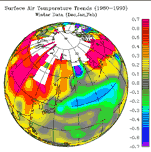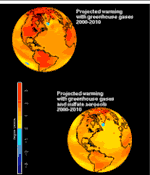How well can Arctic climate be simulated by computer-based models?
Arctic climate: a perspective for modeling
Dr. Amanda Lynch
University of Colorado
Computer climate models have long predicted that global
warming will affect Arctic and subarctic regions earlier
and more dramatically than other parts of the world. A string
of scientific studies released in the past two years show
marked increases in temperature and changes in the sea ice
distribution, precipitation, permafrost distribution and
many other climate variables across much of the Far North.
 |
| Observed trends
in surface air temperature (degrees centigrade), showing
"polar amplification" (largest increases occurring
near the North Pole). Click
here for full-sized image. |
 |
| Increases in surface temperature (degrees centigrade) predicted by the Hadley Centre global model, widely believed to be one of the best current models. Nothe the "polar" amplification" (largest increase near the north pole). Click here for full-sized image. |
One way to understand the natural variations in Arctic climate is from the point of view of atmospheric regimes. A regime is a particular mode of circulation in which the transition time from one mode to another is much shorter than the residence time in a particular mode. The existence of quasi-stationary (that is, fairly constant in time) regimes have been found explicitly both in intermediate models of the atmospheric global circulation and in global climate models. Can such quasi-stationary regimes be diagnosed from observed data? From a synoptic point of view, the existence of persistent anomalies has been well established. Corresponding to this, there seems little doubt that atmospheric regimes can be defined on a sectorial basis. Examples of such sectoral regimes are the North Atlantic Oscillation and the El Niño/Southern Oscillation.
Not only the natural variability of the atmosphere can be viewed in terms of regimes. Recent suggestions have been made that anthropogenic forcing would manifest by a projection onto the patterns of natural internal variability — that is, certain regimes would occur more or less frequently than in the natural state. The winter index of the North Atlantic Oscillation (NAO) is associated with a near-hemispheric pattern of sea level pressure variability, with atmospheric mass shifting between the Icelandic Low and the Azores High. The recent increase in the winter NAO index is thus related to an intensification of both those features and an increase in the Atlantic westerly winds. The NAO can be seen through various manifestations in terms of sea-level pressure (SLP), storm-tracks, sea surface temperature (SST), temperature and precipitation.
Physical understanding of this approach is still problematic — the pattern of forced climate change may resemble one or more states of the systems dominant modes of variation if both are controlled and amplified by the same mechanisms and feedbacks. Thus, this approach does imply that we need models that can simulate circulation regimes and their associated variability if we are to characterize fully the current and future evolution of the Arctic circulation.
It is possible that the zonalization and loss of planetary-wave amplitude, characteristic of many global model integrations, would lead to less sensitivity to change compared with the real atmosphere. In such a situation it is possible that the global model response to anthropogenic forcing would have a weaker projection onto the model's patterns of internal variability than in the real world.
However, this reduced sensitivity must be juxtaposed with the strong polar amplification seen in many global models of climate change. As models become more complex, and include a better and more inclusive representation of the myriad of positive and negative feedbacks in the Arctic and global climate system, this polar amplification response has been mitigated somewhat. The results so far are strongly model dependent, which points to the need for better understanding of the important physical mechanisms and dominant feedbacks in the climate system, and the way these processes interact on a range of timescales. Such understanding must include cryospheric, oceanic and terrestrial processes, as well as the atmosphere. Our understanding of many of these mechanisms or their interactions is sufficiently limited that there remains a strong role for limited area models and individual process models, which are not limited by the important of model bias and errors from other regions of the globe, to continue the investigation.
Although today's climate models are better than ever, further refinement and improvement is necessary. However, accurate model predictions are neither necessary nor sufficient for effective policy responses, and hence with care, model products can be of great use already.
Reference
8/2/2006




